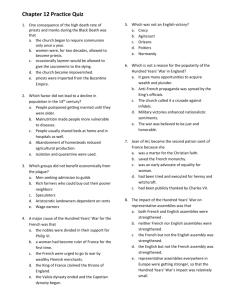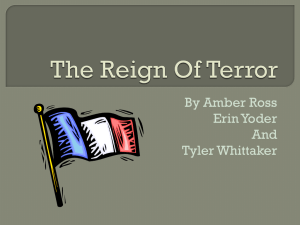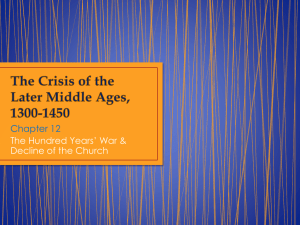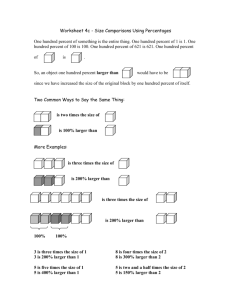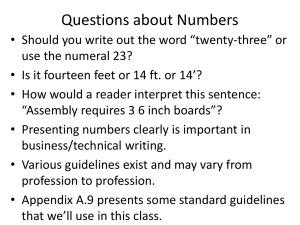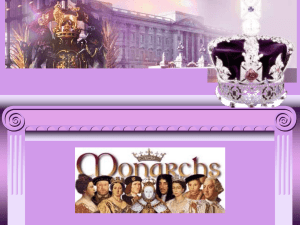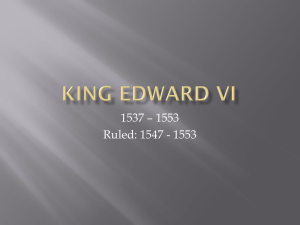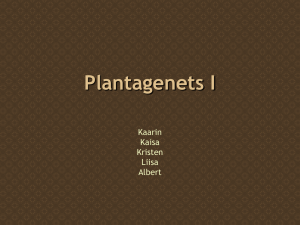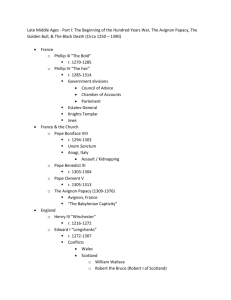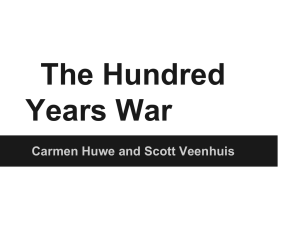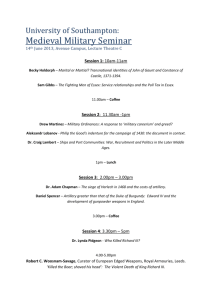AP EURO A Distant Mirror Summer Reading Guide
advertisement
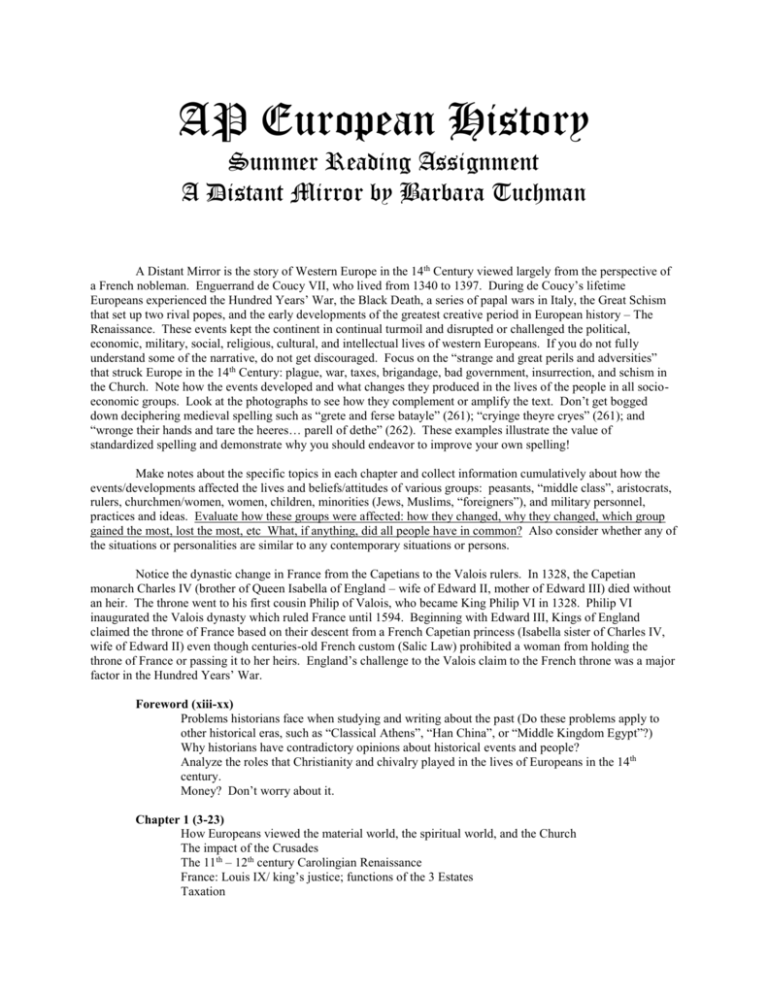
AP European History Summer Reading Assignment A Distant Mirror by Barbara Tuchman A Distant Mirror is the story of Western Europe in the 14th Century viewed largely from the perspective of a French nobleman. Enguerrand de Coucy VII, who lived from 1340 to 1397. During de Coucy’s lifetime Europeans experienced the Hundred Years’ War, the Black Death, a series of papal wars in Italy, the Great Schism that set up two rival popes, and the early developments of the greatest creative period in European history – The Renaissance. These events kept the continent in continual turmoil and disrupted or challenged the political, economic, military, social, religious, cultural, and intellectual lives of western Europeans. If you do not fully understand some of the narrative, do not get discouraged. Focus on the “strange and great perils and adversities” that struck Europe in the 14th Century: plague, war, taxes, brigandage, bad government, insurrection, and schism in the Church. Note how the events developed and what changes they produced in the lives of the people in all socioeconomic groups. Look at the photographs to see how they complement or amplify the text. Don’t get bogged down deciphering medieval spelling such as “grete and ferse batayle” (261); “cryinge theyre cryes” (261); and “wronge their hands and tare the heeres… parell of dethe” (262). These examples illustrate the value of standardized spelling and demonstrate why you should endeavor to improve your own spelling! Make notes about the specific topics in each chapter and collect information cumulatively about how the events/developments affected the lives and beliefs/attitudes of various groups: peasants, “middle class”, aristocrats, rulers, churchmen/women, women, children, minorities (Jews, Muslims, “foreigners”), and military personnel, practices and ideas. Evaluate how these groups were affected: how they changed, why they changed, which group gained the most, lost the most, etc What, if anything, did all people have in common? Also consider whether any of the situations or personalities are similar to any contemporary situations or persons. Notice the dynastic change in France from the Capetians to the Valois rulers. In 1328, the Capetian monarch Charles IV (brother of Queen Isabella of England – wife of Edward II, mother of Edward III) died without an heir. The throne went to his first cousin Philip of Valois, who became King Philip VI in 1328. Philip VI inaugurated the Valois dynasty which ruled France until 1594. Beginning with Edward III, Kings of England claimed the throne of France based on their descent from a French Capetian princess (Isabella sister of Charles IV, wife of Edward II) even though centuries-old French custom (Salic Law) prohibited a woman from holding the throne of France or passing it to her heirs. England’s challenge to the Valois claim to the French throne was a major factor in the Hundred Years’ War. Foreword (xiii-xx) Problems historians face when studying and writing about the past (Do these problems apply to other historical eras, such as “Classical Athens”, “Han China”, or “Middle Kingdom Egypt”?) Why historians have contradictory opinions about historical events and people? Analyze the roles that Christianity and chivalry played in the lives of Europeans in the 14th century. Money? Don’t worry about it. Chapter 1 (3-23) How Europeans viewed the material world, the spiritual world, and the Church The impact of the Crusades The 11th – 12th century Carolingian Renaissance France: Louis IX/ king’s justice; functions of the 3 Estates Taxation Chapter 2 (24-48) Climate problems: what kind of problems, what effects? Evils in the Church and protests against the evils, William of Ockham, Marsilius of Padua Role of Christianity and the Church in people’s beliefs and lifestyle, anti-materialist views Economic outlook, usury, rich vs poor Anti-Semitism, Inquisition Demise of the Capetian dynasty Origins of the Hundred Years’ War Chapter 3 (48-69) Marriage arrangements; importance of “love”, money, and dynastic alliances in marriage Infant and childhood morality, attitudes about children Personal grooming and hygiene Time, calendar, clock, science Literature and learning Chivalry, “courtly love”; monogamy, adultery Chapter 4 (70-91) The Hundred Years’ War : new weapons (long bow, gun); tactics expectations of participants, differing attitudes of French and English knights towards commoners in the armies. Financing the war; money, the economy English economic ties to Flanders, the wool trade Battle of Crecy (Aug. 26th, 1346) Calais Chapter 5 (92-125) Short-term and long-term effects of the Black Death, the 2 types of infection Why Italy was hit the hardest, why poor suffered the most, how death of sheep affected England Medicine allied with astrology, Arab influence, “causes” (as interpreted by them) Anti-Semitic response/ideology Results: matrimony morals, education, taxes, peasants, inflation, plenary indulgences, economic impact. Religion: “theory of indulgences”, conditions in Rome, anti-clericalism Art: depiction of “death”, “Dance Macabre.” Chapter 6 (134-35) Violence in the 14th Century Chapter 7 158-161 Paris in 1356 172-184 Peasants in France and the Jacquerie Chapter 9 208-219 Women, sex, marriage, Church’s view of women Chapter 10 all The problem of mercenaries, their lifestyle, etc Chapter 11 (232-245) Free peasants, advantages, buying labor Lifestyle of nobles in France and Italy – Galeazzo and Bernabo Visconti – their lifestyle, character, daughter’s marriage to Lionel, son of Edward III Chapter 12 249-252 Urban V’s attempt to return to the Papacy 259-262 Jews, Black death, Dancing mania, witchcraft 263-264 Massacre at Limoges, French hatred of the English 266-269 John of Gaunt’s march to Aquitaine, Charles V’s tactics, French plunder people they had “liberated” Events in the second phase of the Hundred Years’ War: In 1371, England los tall the French lands it had gained in 1347-49. The Black Prince, the oldest son of King Edward III of England, left France and returned to England aged 38 and destroyed by dysentery and gout. He died in England six years later. His brother John of Gaunt, led English forces on a disastrous march from Calais to Aquitaine in the summer of 1373. The next year France and England signed a one year truce. Chapter 14 (284-305) Turmoil and lawlessness. Free peasants and the legend of Robin Hood Black Death returns. John Wyclif, Lollardy, anti-clericalism – why does John of Gaunt support Wyclif? Role of John of Gaunt, Sir Peter de la Mare, Parliament, election of Commons, impeachment devised Death of the Black Prince, Chaucer, death of Edward III, ascension of Richard I (10 yrs old) Developing sense of “nation” in France Renewal of the Hundred Years’ War, French depredations in Southern England, “destruction and terror”, attitude of English nobles about the fate of towns/people attacked Chapter 15 306-311 Holy Roman Emperor visiting France – not his education, lavish lifestyle, and entertainments 311-314 Drama, sex, violence 315-319 Religious dissent and sorcery become “evil”, women and sorcery, torture to secure convictions, new images and ideas about the “devil” Chapter 16 (320-339) Anti-papal and anti-clerical sentiments Robert of Geneva – note his role early and later in the chapter Massacre at Cesena Feb. 3rd – 5th 1377; who did it, why, what results Catherine of Siena, Pope Gregory XI Election of Pope Urban VI, his reforms, conflict that follows Election of Pope Clement VII (Robert of Geneva) Schism – why it happened, its effects on people’s thoughts and lives. Whom does Tuchman blame? On 336 Charles V is described as overestimating “his capacity to control events” Role of propaganda in the Great Schism Wyclif comes to turning point – his short-term and long-term impact and fate What ideas, actions, attitudes, etc; are evident that would finally provoke some Europeans to throw off the Catholic Church and the Papacy in the Protestant Reformation?
